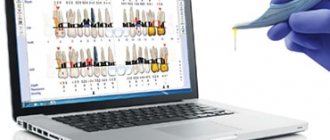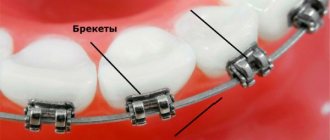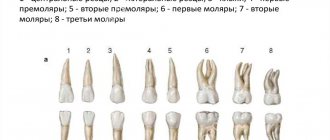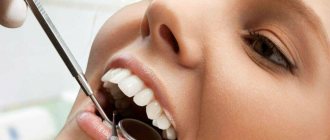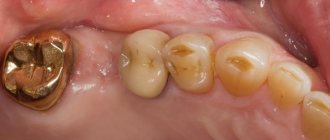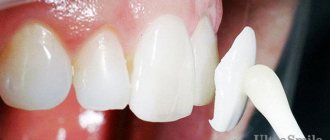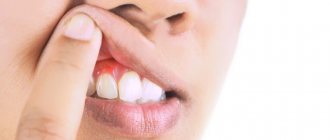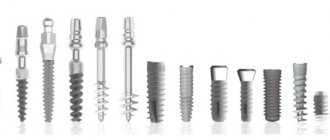The active rhythm of life of a modern person does not always allow you to make an appointment with a doctor after identifying a minor injury that does not cause severe pain or discomfort. After reading the information in this article, you will find out whether you need to worry if a tooth is cracked vertically, whether your situation is serious, and what measures should be taken in this case. In addition, you will learn how to cure a crack and what the possible reasons for its appearance may be - this will help protect yourself in the future to prevent a recurrence of the unpleasant event.
What Causes Injury?
The main reason why tooth crown damage occurs is weakened enamel.
In such cases, microcracks and chips often form, which subsequently lead to a crown fracture. But even strong teeth can be injured under strong mechanical stress, however, this usually happens simultaneously. The reason for the weakening of the enamel can be:
- poor quality dental treatment;
- deficiency of calcium, phosphorus and fluorine;
- violation of nutrition rules;
- constant exposure to food acids;
- disruption of the pancreas with uneven release of acidity;
- the effect of different temperatures when eating food (hot-cold);
- jaw injuries.
With weakened teeth, a crack can also occur as a result of the habit of chewing hard objects or foods, nails, packaging, etc.
Dentists warn that those at greatest risk are patients who have had prior dental treatment with pulp removal or a filling placed on a large, diseased crown cavity.
Diagnostics
Diagnosis of a broken tooth takes place in several stages :
- Examination of the oral cavity.
- Examination with a dental probe - the instrument will get stuck in the crack.
- Palpation: the injured tooth will respond with pain when pressed.
- Application of special dyes to enamel.
- Radiography. With its help, you can determine the depth of the injury and identify intradental cracks.
Important! The most accurate results are shown by examination under a microscope. However, such equipment is only available in endodontic centers.
Features of tooth trauma
A crack in the crown of a tooth can be small in size, and then it can only be identified during a routine examination or diagnosis. Significant damage is noticeable visually.
If a tooth is cracked, it can be saved, but it is important not to ignore the symptoms:
With hidden damage, symptoms may appear:
- non-localized toothache of a permanent nature;
- tooth sensitivity when eating.
If you go to the dentist in a timely manner, you can save a chipped tooth. However, if you ignore the symptoms, complications may arise:
- infection or inflammation of the pulp or gums;
- tissue necrosis;
- soft tissue tumor;
- bleeding gums;
- tooth root mobility;
- tooth displacement.
For the purpose of tooth reconstruction, patients turn to the dentist much more often for aesthetic reasons, when a defect spoils the smile. It should be understood that a crown crack is a pathology and requires not only its restoration, but also treatment of the consequences of the injury.
Complications
The human body always tries to cleanse itself of dangerous substances and particles, so it is possible that over time the unremoved root element will “come out” on its own. But it is unreasonable to hope that this will happen. If the image confirms the presence of a fragment in the hole, it is necessary to remove it surgically. Otherwise, you may encounter dangerous complications, including:
- Acute inflammatory process in the root area. A large amount of pus is released, the tissues become severely inflamed. The roots of neighboring units or even the entire dentition may be damaged. It is possible that the abscess will spread to the periosteum.
- Osteomyelitis. Damage to the jaw of an infectious nature. Pathogenic microorganisms actively multiply in the unhealed hole. As a result, osteonecrosis develops - the jaw tissue begins to die. Pathology can occur in acute, subacute and chronic form. The patient feels weakness and headaches. The oral mucosa turns red, the lymph nodes become enlarged. If osteomyelitis is not stopped in time, it can develop into meningitis, meningoencephalitis, sepsis, or brain abscess.
- Inflammation of the periosteum. The gums swell, and when pressed, a sharp pain appears. The roots of units located on both sides of the inflamed hole may be affected. Treatment involves eliminating the root cause of the disorder and carrying out long-term antibiotic therapy.
- Sharp pain radiating to the neck. It is neurological in nature. It is the result of an inflammatory lesion of the jaw.
- Phlegmon. The gums swell and hurt. Purulent exudate is released from it. The neck and cheek become swollen. The patient's general well-being worsens.
All consequences of a root element not removed from the hole are dangerous. Therefore, if you suspect that your tooth has not been completely removed, be sure to take a photo and consult with an experienced dentist. This way you will avoid many health problems.
What types of cracks are there?
Damage to the dental crown can have different localization and direction. The nature of the crack largely affects the ability to preserve the natural crown, and sometimes the tooth itself.
First of all, cracks are divided into two types: external and internal. Hidden injuries are considered more dangerous when damage to the root or pulp occurs. The chances of saving a tooth if the root has fractured are slim. In case of concomitant pathologies, for example, inflammation of the pulp, dentists preferentially resort to tooth extraction.
Depending on the direction, there are three types of injury.
- Diagonal. The crack runs from bottom to top in an oblique direction. If a tooth is cracked to the root, it can be saved, but only if there is no damage to the internal tissues. Even a complex crown fracture can be restored using composite materials.
- Horizontal. These injuries are the most common and predominantly occur as a result of trauma to the jaw. When a tooth is split in half horizontally, it can be saved. Depending on the area of the chip, a composite material or orthopedic pads attached to pins can be used.
- Vertical. The crack on the crown runs vertically. Visually, it gives the impression that the tooth is split into two parts. The longer the crack, the higher the likelihood of damage to internal tissues, including the jaw bones.
Dentists pay attention to eliminating damage to chewing teeth. Chewing function directly depends on the strength of the crown. A damaged tooth can no longer fully perform its function. A vertical crack in your teeth may require crowns on your molars or veneers on your front teeth.
Causes of cracked teeth
Among the causes of tooth chipping are:
- injuries and fractures of the tooth root during training, at home,
- bad habits (cracking nuts, opening bottles with your mouth),
- bruxism (grinding of incisors),
- inept dental treatment, prosthetics, which leads to a fracture of the tooth root, its splitting into two parts,
- lack of calcium and fluoride,
- simultaneous intake of ice-cold and too hot foods.
If the enamel has burst, it is important to immediately contact your dentist about the problem. Such injuries can lead to serious complications, such as tooth root fracture, the symptoms of which may not appear immediately. This increases the risk of unit loss and oral soft tissue infection. Timely treatment will prevent the destruction of the crown and root and help avoid removal.
Dentists' recommendations
If a tooth is cracked, you can save it, but you should make an appointment with your dentist right away. The sooner professional help is provided, the less likely there are complications.
Before visiting a doctor, you should adhere to the following recommendations:
- the load on the injured tooth is completely eliminated;
- take only soft or ground food of medium temperature;
- Every hour, rinse your mouth with antiseptic agents, saline solutions or herbal decoctions.
Experts strongly advise against touching a damaged tooth with your fingers or tongue. You should not loosen it or try to use any popular recommendations. When a tooth is cracked, it can only be saved by going to the dentist.
When to use crowns
If the destruction is significant, the dentist will suggest installing a veneer or crown.
Crowns are made from:
- Porcelain or composite resins are the most natural-looking materials;
- Metal – these crowns are the strongest.
If the coronal part is destroyed and the root remains intact, the patient will have a pin installed and covered with a crown.
To install a crown, two visits to the doctor are required:
- At the first appointment, an x-ray is taken, the teeth are ground, an impression is made, and a temporary crown is placed;
- At the second visit, the patient receives a permanent crown.
Before deciding on treatment for an injured tooth, the doctor orders an x-ray to understand the condition of the root. Not in all cases it is possible to save the tooth.
Indications for tooth extraction
- The remains of the root part are too fragile to be used as a basis for restoration;
- There is caries damage;
- The chip goes into the deep root part;
- The root is unstable;
- Atypical tooth location;
- The remaining part of the tooth is loose.
In case of removal, the issue of implantation is considered - instant or performed using the classical technique.
When using instant implantation, bone tissue is not built up - an artificial root is implanted immediately after tooth extraction. The main condition is a healthy jaw. If there are contraindications for using this option, a procedure for increasing the volume of bone tissue and introducing an implant in the classical way can be performed. Before the choice of method is made, the dentist conducts an examination and identifies the patient’s characteristics. If necessary, an orthodontist or other specialist is consulted if problems are identified.
Methods of treatment and restoration
If a tooth is cracked, whether it can be saved will depend directly on the nature of the injury and the time after which the person went to the dentist. With a high probability, you can save a tooth with small chips and microcracks. The use of composite materials will allow you to restore the crown without visible aesthetic defects.
The situation is much more complicated with extensive cracks. Crown restoration and treatment are carried out only if at least a third of the tooth root is preserved and there are no inflammatory or infectious processes.
In case of significant vertical or diagonal cracks, dentists remove one part of the crown and build up the second half or install a prosthesis on implants. Such manipulations are necessary, because even if the crack has not reached the base of the tooth, under load it will still crack the tooth and its integrity will require re-treatment after some time. Damage to the root system, jaw tissue, and pulp is performed by tooth extraction. Extraction is also used for damaged wisdom teeth.
If a tooth is cracked in half, it can be saved, but only partially if there is no serious damage. You should not delay your visit to the doctor. Modern dentistry has enormous possibilities for restoring teeth; even if removal is required, the crown can be restored with the help of prostheses that will not differ from the rest of the teeth.
Stages of cracks in teeth with photos
The fate of a tooth with a mother-in-law is different in each specific case. The possibility of its preservation is influenced by the nature of the chip and crack, the location and scale of the fracture. The specialist evaluates the tooth fracture, checks whether the pulp is affected, looks at where the crack is located, and whether it has reached the root.
- Vertical cracks. When a tooth has deep cracks along the enamel, its body is completely damaged. The unit cannot be saved. The photo shows an example of this type of crack.
- Horizontal. If the crack is close to the gum, chipping is possible.
- Diagonal. They affect the crown at an angle and require professional dental care.
- Internal. They are invisible, therefore they are considered the most unpredictable and insidious. They can be identified during x-ray diagnostics, but much more often the doctor discovers such injuries when the root of a tooth is fractured.
- Cracks at the root. They occur separately or with any of the described types of cracks. It is impossible to save a tooth with this pathology; it is often accompanied by a root fracture.
Why is it necessary to restore teeth?
If a chewing tooth has collapsed, you should consult a doctor as soon as possible. Loss of a dental unit leads to:
- to displacement of adjacent teeth,
- uneven distribution of chewing load,
- various diseases of the gastrointestinal tract,
- development of complexes and decreased self-esteem.
When you smile, decayed teeth may not be visible, but it is important to remember that they are breeding grounds for bacteria. They cause bad breath and pain when eating cold or hot food.

